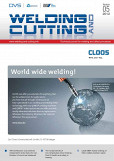Approaches for a better understanding of the formation and reduction of welding fumes in GMA welding under consideration of innovative welding processes
Author: Dr.-Ing. Sascha Rose
GMAW processes are of very great economic importance in mechanised
and automated production. Despite the great technical advancements during
the last years, the acceptance of the process suffers from high emissions,
particularly from welding fumes. Welding fumes are airborne particles
which mainly consist of metal oxides. Moreover, radiation and gases are
emitted. The exposure of welders and operators to fumes and gases is currently
reduced by extraction systems, extraction torches and breathing
masks. Although the arc process is the source of emission, the process
itself has not been developed specifically with regard to low fume formation
rates until now. As basic research for future low-emission GMAW processes,
investigations into the formation mechanisms of welding fumes were carried
out in the EWM Award “Physics of Welding“. Despite the variety of
fume measurements in the past, the causal mechanisms are not fully understood
yet. Only with the understanding of these mechanisms can effective
strategies be derived to counteract the formation of emissions and to
reduce the hazard potential of the process. In the first place, investigations
were carried out into pulsed processes which are known to emit few welding
fumes. The pulsed arc offers many adjustable process parameters in comparison
to short arcs and spray arcs. Subsequently, experiments with conventional
and modified (reduced-energy) short arcs as well as experiments
with conventional and modified (forced) spray arcs were carried out in
order to investigate the potential of modern variants for reducing welding
fume emissions. The results show that the fume emissions of GMAW
processes and therefore the hazard potential for welders and operators
can be reduced significantly.
An active subscription enables you to download articles or entire issues as PDF-files. If you already are a subscriber, please login. More information about the subscription













